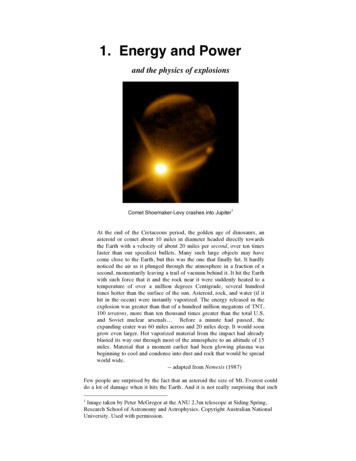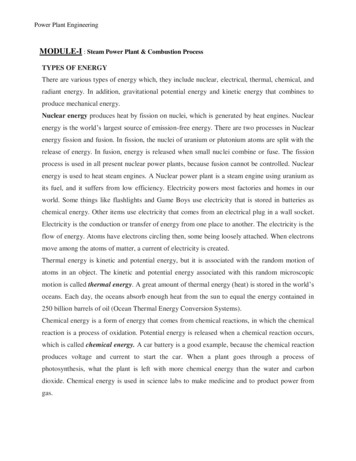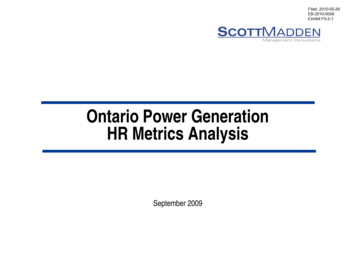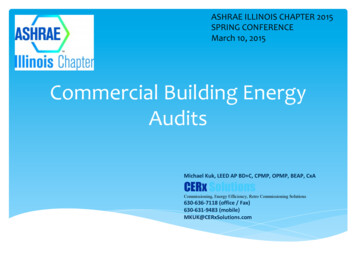
Transcription
1. Energy and Powerand the physics of explosions1Comet Shoemaker-Levy crashes into JupiterAt the end of the Cretaceous period, the golden age of dinosaurs, anasteroid or comet about 10 miles in diameter headed directly towardsthe Earth with a velocity of about 20 miles per second, over ten timesfaster than our speediest bullets. Many such large objects may havecome close to the Earth, but this was the one that finally hit. It hardlynoticed the air as it plunged through the atmosphere in a fraction of asecond, momentarily leaving a trail of vacuum behind it. It hit the Earthwith such force that it and the rock near it were suddenly heated to atemperature of over a million degrees Centigrade, several hundredtimes hotter than the surface of the sun. Asteroid, rock, and water (if ithit in the ocean) were instantly vaporized. The energy released in theexplosion was greater than that of a hundred million megatons of TNT,100 teratons, more than ten thousand times greater than the total U.S.and Soviet nuclear arsenals Before a minute had passed, theexpanding crater was 60 miles across and 20 miles deep. It would soongrow even larger. Hot vaporized material from the impact had alreadyblasted its way out through most of the atmosphere to an altitude of 15miles. Material that a moment earlier had been glowing plasma wasbeginning to cool and condense into dust and rock that would be spreadworld wide.-- adapted from Nemesis (1987)Few people are surprised by the fact that an asteroid the size of Mt. Everest coulddo a lot of damage when it hits the Earth. And it is not really surprising that such1Image taken by Peter McGregor at the ANU 2.3m telescope at Siding Spring,Research School of Astronomy and Astrophysics. Copyright Australian NationalUniversity. Used with permission.
1-2bodies are out there. The danger has been the subject of many movies, includingDeep Impact, Meteor, and Armageddon. Asteroids and comets frequently comeclose to the Earth. Every few years, there is a newspaper headline about a “nearmiss” in which an object misses the Earth by “only a few million miles.” That ishardly a near miss. The radius of the Earth is about 4000 miles. So a miss by, say,four million miles would be a miss by a thousand Earth radii. Hitting the Earth iscomparable to hitting an ant on a dartboard.Although the probability of an asteroid impact during your lifetime is small,the consequences could be huge, with millions or maybe even billions of peoplekilled. For this reason, the US government continues to sponsor both asteroidsearches, to identify potential impactors, and research into ways to deflect ordestroy such bodies.But why should an asteroid impact cause an explosion? The asteroid wasmade of rock, not dynamite. And why would it cause such a big explosion? Butthen--what is an explosion, after all?Explosions and energyAn explosion occurs when a great deal of stored energy is suddenly converted intoheat in a confined space. This is true for a grenade, an atomic bomb, or an asteroidhitting the Earth. The heat is enough to vaporize the matter, turning it into anextremely hot gas. Such a gas has enormous pressure, that is, it puts a great forceon everything that surrounds it. Nothing is strong enough to resist this pressure, sothe gas expands rapidly and pushes anything near it out of the way. The flyingdebris is what does the damage in an explosion. It doesn’t matter what the originalform of the energy is; it could be kinetic energy (the result of motion) like theenergy of the asteroid, or chemical energy like the energy in the explosive TNT(trinitrotoluene). It is the rapid conversion of this energy into heat that is at theheart of most explosions.You may have noticed that I used a lot of common terms in the previousparagraph that I didn’t explain. Words such as energy and heat have everydaymeanings, but they also have precise meanings when used in physics. Physics canbe derived in a deductive way, just like geometry, but it is hard to learn in thatmanner. So our approach will be to start with intuitive definitions, and then makethem more precise as we delve deeper into the physics. Here are some beginningdefinitions that you may find helpful. The precise meanings of these definitionswill become clearer over the next three chapters.Definitions (donʼt memorize)Energy is the ability to do work. (Work is defined numerically as the magnitudeof a force multiplied by the amount the force moves in the direction of the force.)Alternative definition for Energy: anything that can be turned into heat. 2Heat is something that raises the temperature of a material, as measured by athermometer. (It will turn out that heat is actually the microscopic energy ofmotion of vibrating molecules.)2It is likely, as the Universe evolves, that virtually all energy will be convertedinto heat. This idea has spawned numerous essays by philosophers andtheologians. It is sometimes called the “heat death” of the Universe, since heatenergy cannot always be converted back to other forms.
1-3These definitions sound great to the professional physicist, but they might besomewhat mysterious to you. They don’t really help much since they involve otherconcepts (work, force, energy of motion) that you may not precisely understand.I’ll talk more about all these concepts in the coming pages. In fact, it is verydifficult to understand the concept of energy just from the definitions alone.Trying to do so is like trying to learn a foreign language by memorizing adictionary. So be patient. I’ll give lots of examples, and those will help you to feelyour way into this subject. Rather than read this chapter slowly, I recommend thatyou read it quickly, and more than once. You learn physics by iteration, that is, bygoing over the same material many times. Each time you do that, it makes a littlemore sense. That’s also the best way to learn a foreign language: total immersion.So don’t worry about understanding things just yet. Just keep on reading.Amount of EnergyGuess: how much energy is there in a pound of an explosive, such as dynamite orTNT, compared to, say, a pound of chocolate chip cookies? Don’t read any moreuntil you’ve made your guess.Here’s the answer: it is the chocolate chip cookies that have the greaterenergy. Not only that, but the energy is much greater--eight times greater in thecookies than in TNT!That fact surprises nearly everybody, including many physics professors. Tryit out on some of your friends who are physics majors.How can it be? Isn’t TNT famous for the energy it releases? We’ll resolve thisparadox in a moment. First, let’s list the energies in various different things. Thereare a lot more surprises coming, and if you are investing in a company, or runningthe U.S. government, it is important that you know many of these facts.To make the comparisons, lets consider the amount of energy in one gram ofvarious materials. (A gram is the weight of a cubic centimeter of water; a pennyweighs 3 grams. There are 454 grams in a pound.) I’ll give the energy in severalunits: the Calorie, the calorie, the watt-hour, and the kilowatt-hour.CalorieThe unit you might feel most familiar with is the Calorie. That’s the famous“food calorie” used in dieting. It is the one that appears on the labels of foodpackages. A chocolate chip (just the chip, not the whole cookie) contains about 3Calories. A 12-ounce can of Coca Cola has about 150 Calories.Beware: if you studied chemistry or physics, you may have learned the unitcalled the calorie. That is different from the Calorie! A food Calorie (usuallycapitalized) is 1000 little physics calories. That is a terrible convention, but it isnot my fault. Physicists like to refer to food Calories as kilocalories. Food labels inEurope and Asia frequently say “kilocalories”, but not in the U.S. So 1 Cal 1000cal 1 kilocalorie.3Kilowatt-hourAnother famous unit of energy is the “kilowatt-hour”, abbreviated kWh. (TheW is capitalized, some say, because it stands for the last name of James Watt, butthat doesn’t explain why we don’t capitalize it in the middle of the word kilowatt.)What makes this unit famous is that we buy electricity from the power company inkWh. That’s what the meter outside the house measures. One kWh costs between 53I got into trouble in a cake recipe once because I didn’t know the differencebetween a Tsp and a tsp of baking powder. In fact, 1 Tsp 3 tsp. Ask a cook!
1-4and 25 cents, depending on where you live. (Electric prices vary much more thangasoline prices.) We’ll assume the average price of 10 cents per kWh in this text.It probably will not surprise you that there is a smaller unit called the watthour, abbreviated Wh. A kilowatt-hour consists of a thousand watt-hours. This unitisn’t used much, since it is so small. Its main value is that a Wh is approximately 1Calorie4. So for our purposes, it will be useful to know that:Wh 1 Calorie (approximately)1kWh 1000 CaloriesJoule. Physicists like to the use energy unit called the joule (named after JamesJoule) because it makes their equations look simpler. There are about 4000 joulesin a Calorie, 3600 in a Wh, 3.6 million in a kWh.The energy table below shows the approximate energies in various substances.I think you’ll find that this table is one of the most interesting ones in this entiretextbook. It is full of surprises. The most interesting column is the last one.Energy per gramobjectbullet (at sound speed, 1000 ft per sec)battery (auto)battery (rechargeable computer)battery (alkaline flashlight)TNT (the explosive trinitrotoluene)modern High Explosive (PETN)chocolate chip cookiescoalbutteralcohol (ethanol)gasolinenatural gas (methane, CH4)hydrogen gas or liquid (H2)asteroid or meteor (30 km/sec)uranium-235Calories(or Watt-hours)0.01.030.10.150.651567610132610020 027,00042,00054,000110,000450,00082 billioncompared toTNT0.0150.050.150.2311.6810111015204016530 millionNote: many numbers in this table have been rounded off.Stop reading now, and ponder the table of energies. Concentrate on the lastcolumn. Look for the numbers that are surprising. How many can you find? Circlethem. My answers are below.I think all of the following are surprises:the very large amount of energy in chocolate chip cookiesthe very small amount of energy in a battery (compare to gasoline!)the high energy in a meteor, compared to a bullet or to TNTthe enormous energy available in uranium, compared to anything else inthe table4to an accuracy of 16%.
1-5Try some of these facts on your friends. Even most physics majors will besurprised. These surprises and some other features of the table are worthy of muchfurther discussion. They will play an important role in our energy future.Discussion of the table of energiesLet’s pick out some of the more important and surprising facts shown in theenergy table and discuss them in more detail.TNT vs. chocolate chip cookiesBoth TNT and chocolate chip cookies store energy in the forces between theiratoms. That’s like the energy stored in compressed springs; we’ll discuss atoms inmore detail soon. Some people like to refer to such energy as chemical energy,although this distinction isn’t really important. When TNT is exploded, the forcespush the atoms apart at very high speeds. That’s like releasing the springs so theycan suddenly expand.One of the biggest surprises in the energy table is that chocolate chip cookies(CCCs) have eight times the energy as the same weight of TNT. How can that betrue? Why can’t we blow up a building with CCCs instead of TNT? Almosteveryone who hasn’t studied the subject assumes (incorrectly) that TNT releases agreat deal more energy than cookies. That includes most physics majors.What makes TNT so useful for destructive purposes is that it can release itsenergy (transfer its energy into heat) very, very quickly. The heat is so great thatthe TNT becomes a gas that expands so suddenly that it pushes and shatterssurrounding objects. (We’ll talk more about the important concepts of force andpressure in the next chapter.) A typical time for 1 gram of TNT to release all of itsenergy is about one millionth of a second. Such a sudden release of energy canbreak strong material.5 Power is the rate of energy release. CCCs have highenergy, but the TNT explosion has high power. We’ll discuss power in greaterdetail later in this chapter.Even though chocolate chip cookies contain more energy than a similarweight of TNT, the energy is normally released more slowly, through a series ofchemical processes that we call metabolism. This requires several chemicalchanges that occur during digestion, such as the mixing of food with acid in thestomach and with enzymes in the intestines. Finally, the digested food reacts withoxygen taken in by the lungs and stored in red blood cells. In contrast, TNTcontains all the molecules it needs to explode; it needs no mixing, and as soon aspart of it starts to explode, that triggers the rest. If you want to destroy a building,you can do it with TNT. Or you could hire a group of teenagers, give themsledgehammers, and feed them cookies. Since the energy in chocolate chip cookiesexceeds that in an equal weight of TNT, each gram of chocolate chip cookies willultimately do more destruction than would each gram of TNT.Note that we have cheated a little bit. When we say there are 5 Cal per gram inCCCs, we are ignoring the weight of the air that combines with the CCCs. Incontrast, TNT contains all the chemicals needed for an explosion, CCCs need tocombine with air. Although air is “free” (you don’t have to buy it when you buythe CCCs), part of the reason that CCCs contain so much energy per gram is thatthe weight of the air was not counted. If we were to include the weight of the air,5As we’ll see in Chapter 3, to calculate the force, you can take the energy of asubstance like TNT and divide it by the distance over which it is released (fromchemical to kinetic energy).
1-6the energy per gram would be lower, about 2.5 Calories per gram. That’s stillalmost four times as much as for TNT.The surprisingly high energy of gasolineAs the energy table shows, gasoline contains significantly more energy per gramthan cookies, butter, alcohol or coal. That’s why it is so valuable as fuel. This factwill be important when we consider alternatives to gasoline for automobiles.Gasoline releases its energy (turns it into heat) by combining with oxygen, soit must be well mixed with air to explode. In an automobile, this is done by aspecial device known as a fuel injector; older cars use something called acarburetor. The explosion takes place in a cylindrical cavity known, appropriately,as the cylinder. The energy released from the explosion pushes a piston down theaxis of the cylinder, and that is what drives the wheels of the car. An internal“combustion” engine can be thought of as an internal “explosion” engine.6 Themuffler on a car has the job of making sure that the sound from the explosion ismuffled, and not too bothersome. Some people like to remove the muffler-especially some motorcyclists--so that the full explosion is heard; this can give theillusion of much greater power. Removing the muffler also lowers the pressure justoutside the engine, so that the power to the wheels is actually increased, althoughnot by very much. We’ll talk more about the gasoline engine in the next chapter.The high energy per gram in gasoline is the fundamental physics reason whyit is so popular. Another reason is that when it burns, all the residues are gas(mostly carbon dioxide and water vapor) so there is no residue to remove. Incontrast, for example, most coal leaves a residue of ash.The surprisingly low energy in batteriesA battery also stores its energy in chemical form. It can use its energy to releaseelectrons from atoms (we’ll discuss this more in Chapters 2 and 6). Electrons cancarry their energy along metal wires and deliver their energy at another place;think of wires as pipes for electrons. The chief advantage of electric energy is thatit can be easily transported along wires and converted to motion with an electricmotor.A car battery contains 340 times less energy than an equal weight of gasoline!Even an expensive computer battery is about 100 times worse than gasoline. Thoseare the physics reasons why most automobiles use gasoline instead of batteries astheir source of energy. Batteries are used to start the engine because they arereliable and fast.Battery-powered carsA typical automobile battery is also called a lead-acid battery, because it usesthe chemical reaction between lead and sulfuric acid to generate electricity. Thetable shows that such batteries deliver 340 times less energy than gasoline.However, the electric energy from a battery is very convenient. It can be convertedto wheel energy with 85% efficiency; put another way, only 15% is lost in runningthe electric motor. A gasoline engine is much worse: only 20% of the energy ofgasoline makes it to the wheels; the remaining 80% is lost as heat. When you put6Engineers like to make a distinction between an explosion, in which an abruptfront called a shock wave is generated which passes through the rest of thematerial and ignites it, and a deflagration, in which there is no shock wave. Thereis no shock wave in the detonation of gasoline in an automobile, so by thisdefinition, there is no explosion in an automobile engine. Newspapers and thegeneral public do not make this fine distinction, and in this book, neither will I.
1-7in those factors, the advantage of gasoline is reduced from 340 down to a factor of80. So, for automobiles, batteries are only 80 times worse that gasoline. Thatnumber is small enough to make battery-driven autos feasible. In fact, every sooften you’ll read in the newspaper about someone who has actually built one. Atypical automobile fuel tank holds about 100 pounds of gasoline. (A gallon ofgasoline weighs about 6 pounds.) To have batteries that carry the energy in 100pounds of gasoline would take 80 times that weight, that is, 800 pounds ofbatteries. But if you are willing to halve the range of the car, from 300 miles to150, then the weight is down to 400 pounds. If you only need 75 miles tocommute, then the weight is only 200 pounds.Why would you trade a gasoline car for one that could go only 75 miles? Theusual motivation is to save money. Electricity bought from the power company,used to charge the battery, costs only 10 cents per kWh. Gasoline costs (as of thiswriting) about 2.50 per gallon. When you translate that into energy delivered tothe wheels, that works out to about 40 cents per kWh. So electricity is 4 timescheaper! Actually, it isn’t quite that good. When most people work out thosenumbers, they ignore the fact that standard lead-acid car batteries have to bereplaced after, typically, 700 charges. When you include the battery expense, thecost per kWh is about 20 cents per kWh. It beats the cost of gasoline by a factor oftwo. But because batteries take so much space, it’s not an attractive option forpeople who value trunk space.Batteries have additional advantages in some circumstances. In World War II,when submarines had to submerge and could not obtain oxygen, their energysource was a huge number of batteries stored beneath the decks. When on thesurface, or “snorkeling depth,” the submarines ran on diesel fuel, a form ofgasoline. The diesel fuel also ran generators that recharged the batteries. So duringWWII, most submarines spent most of their time on the surface, recharging theirbatteries. Watch an old World War II movie, and they don’t show that; you get themisimpression that the subs were always below water. Modern nuclear submarinesdon’t require oxygen, and they can remain submerged for months. That greatlyincreases their security against detection.Electric Car HypeSuppose we use better batteries, ones that hold more energy per gram. Astudent drew my attention to an article that appeared in a magazine about such acar called the “Tesla Roadster.” It is powered by 6,831 rechargeable lithium-ionbatteries, similar to those found in laptop computers. The car range is 250 miles.They claim, if you charge the batteries from your home power plug, that drivingthe car costs 1 to 2 cents per mile. Top speed: 130 miles per hour. Wow! Can’twait to get one? The cars will be built in a factory in England and they weresupposed to be available by 2008.The catch is in the cost of the batteries. Lead-acid batteries, the ones that weconsidered for the electric car calculation above, cost about a dollar per pound ofbattery. ( 50 for 50 pounds.) A good computer battery costs about 100 perpound ( 100 for a one pound battery). When we included replacement costs, thelead-acid batteries cost 10 cents per kWh; a similar calculation shows thatcomputer batteries cost about 4 per kWh. That’s ten times as much as the cost ofgasoline! So, when you consider the cost of replacing the batteries, electric cars arefar more expensive to operate than our standard gasoline cars.There is a lot of hype about “who killed the electric car.” Some people say itwas the oil industry, because they didn’t want a cheaper alternative. But theelectric car is not cheaper, unless you are willing to live with the very short range(and heavy) version that uses lead-acid batteries.
1-8Hybrid autosDespite the limitations of batteries, there is a fascinating new technology calledhybrid automobiles. In a hybrid, a small gasoline engine provides energy to chargea battery; the car then gets its energy from the battery. This has more value thanyou might guess: the gasoline engine can be run at a constant rate, under idealconditions, and as a result, it is two to three times as efficient as the engine inordinary cars. In addition, hybrid engines can convert some of the mechanicalmotion of the automobile (e.g. its extra speed picked up when descending a hill)back into stored chemical energy in the rechargeable battery. It does this instead ofusing brakes – which only turn the energy of motion into heat. Hybrid engines arebecoming very popular, and in a few years, they may be the most common type ofautomobile, particularly if gasoline prices stay high or rise. Hybrid autos can getabout 50 miles per gallon (that’s what I get with my Toyota Prius, if I drive withlow accelerations), considerably better than the 30 miles per gallon that similarnon-hybrid autos get.Many people complain that their hybrids do not have the facility to charge upfrom the wall plug. The American version of the Prius can only get its energy fromits own gasoline engine. Apparently in Japan people can charge the battery fromthe electric grid, and on the internet you can find clubs that show you how tochange your Prius to accomplish just that too. The people who do this mistakenlythink they are saving money. They aren’t, for the same reason I articulated whendiscussing all electric autos. It is likely that the batteries in the hybrid can only becharged about 500 times. After that, they will have to be replaced, and that willmake the average cost per mile much higher. In the current Prius, the batteries areused only during moments when the gasoline engines would be inefficient, such asduring rapid acceleration. With this limited use, the batteries will last much longer.It is not clear how much longer that will be, but it could conceivably affect oldercars.Hydrogen vs. gasoline -- and the fuel cellNotice from the energy table that hydrogen gas has 2.6times more chemical energy per gram than gasoline.Popular articles about the future “hydrogen economy” arepartially based on this fact. In 2003, President George W.Bush announced a major program with the goal of makinghydrogen into a more widely-used fuel.Another attractive feature of hydrogen is that the onlywaste product it produces is water, created when thehydrogen is chemically combined with oxygen from the airto make H2O (water). Moreover, the conversion can bedone with high efficiency by using an advanced technologycalled a fuel cell to convert the chemical energy directlyinto electricity.A fuel cell looks very much like a battery, but has adistinct advantage. In a battery, once the chemical is usedup, you have to recharge it with electricity producedelsewhere, or throw it away. In a fuel cell, all you have todo is provide more fuel (e.g. hydrogen and oxygen). Thefigure on the left shows a setup to demonstrate“electrolysis” in which electricity is passed between twoterminals through water, and hydrogen and oxygen gas areproduced at the terminals.
1-9A fuel cell is very similar to an electrolysis apparatus, but it is run backwards.Hydrogen and oxygen gas are compressed at the electrodes, they combine to formwater, and that makes electricity flow through the wires that connect one terminalto the other. So the diagram on the left can also represent a fuel cellThe main technical difficulty of the hydrogen economy is that hydrogen is notvery dense. Even when liquefied, it has a density of only 0.071 grams per cubiccentimeter (cc), a factor of 10 times less than gasoline. As we saw in the energytable, per gram, hydrogen has 2.6 times more energy than gasoline. Put thesetogether, and we find that liquid hydrogen stores only 0.071 x 2.6 0.18 times asmuch energy per cubic centimeter (or per gallon) as gasoline. That is a factor of 5times worse. However, many experts say the factor is only 3 times worse, sincehydrogen can be used more efficiently than gasoline. It is useful to remember thefollowing approximate numbers; you will find them valuable when discussing thehydrogen economy with other people.Remember this: Compared to gasoline, liquid hydrogen has3 x more energy per gram (or per lb)3 x less energy per gallon (or per liter)Here’s another approximate rule that is easy to remember. In terms of energythat can be delivered to a car:1 kilogram of hydrogen 1 gallon of gasolineHydrogen liquid is dangerous to store since it expands by a factor of athousand if warmed. If you protect against that with a thick-walled tank, you mightas well store the hydrogen as a high-pressure gas. At a pressure of 10,000 poundsper square inch (66 times atmospheric pressure) the gas is almost half as dense ashydrogen liquid. But that factor of half makes it even harder to fit hydrogen into areasonable space.Compared to gasoline, compressed gas hydrogen has6 x less energy per gallon (or per liter)And the tank to contain the hydrogen typically weighs 10 to 20 times as muchas the hydrogen itself. That takes away the weight advantage too.Because hydrogen takes up so much space (even though it doesn’t weighmuch) it may be used for buses and trucks before it is used for automobiles. It isalso possible that hydrogen will be more valuable as a fuel for airplanes, since forlarge airplanes the low weight of the hydrogen may be more important than thefact that it takes more volume than gasoline. Fuel cells first achieved prominencein the space program as the energy storage method used by the astronauts. For themission to the Moon, low weight was more important than the space that could besaved in the capsule. Moreover, the water that was produced could be used by theastronauts, and there was no waste carbon dioxide to eject.Fuel cell developed by NASA. Hydrogen gas entersthrough the inlet on the top. Air enters though someof the circular openings, and carbon dioxide leavesthrough the others. The electric power comes fromthe wires in the back.
1-10A technical difficulty with liquid hydrogen is that it boils at a temperature of –423 degrees Fahrenheit. This means that it must be transported in special thermosbottles (technically known as dewars). Either that, or it can be transported in aform in which it is chemically or physically combined with other materials at roomtemperature, although that greatly increases the weight per Calorie. A morepractical alternative may be to transport it as compressed gas, but then the weightof the pressure tank actually exceeds the weight of the hydrogen carried.You can’t mine hydrogen! There is virtually no hydrogen gas (or liquid) in theenvironment. There’s lots of hydrogen in water and in fossil fuels (hydrocarbons)– but not “free” hydrogen, the molecule H2. That’s what we want for the hydrogeneconomy. Where can the hydrogen we need come from? The answer is that wehave to “make” it, that is, release it from the compounds of water or hydrocarbons.Hydrogen gas must be obtained by electrolysis of water, or by breaking apart thehydrogen found in natural (methane) gas. Doing either one takes energy.A typical hydrogen production plant of the future would start with a powerplant fueled by coal, gasoline, nuclear fuel, or solar energy. That power plantmight use this energy to convert ordinary water into hydrogen and oxygen(through electrolysis, or though a series of chemical reactions known as “steamreforming”). Then, for example, the hydrogen could be cooled until it is turnedinto a liquid, and then transported to the consumer. When hydrogen is obtained inthis manner, you only get back out of the hydrogen some the energy that you put into make it. A reasonable estimate is that the fraction of the original energy (used tocreate the hydrogen) that gets to the wheels of the car is about 20%. Thus:hydrogen is not a source of energy.It is only a means for transporting energy.Many people who favor the hydrogen economy believe that the source ofhydrogen will be methane gas. Methane molecules consist of one carbon atom andfour hydrogens. That’s why the chemical formula is CH4. When methane is heatedwith water to high temperatures, the hydrogen in the methane is released, alongwith carbon dioxide. Since carbon dioxide is considered an air pollutant (see thesection on the greenhouse effect and global warming), this method of productionmay not be optimum, but it is probably the cheapest way to make hydrogen.Although the fuel
close to the Earth. Every few years, there is a newspaper headline about a “near miss” in which an object misses the Earth by “only a few million miles.” That is hardly a near miss. The radius of the Earth is about 4000 miles. So a miss by, say, four million miles would be a miss by a











